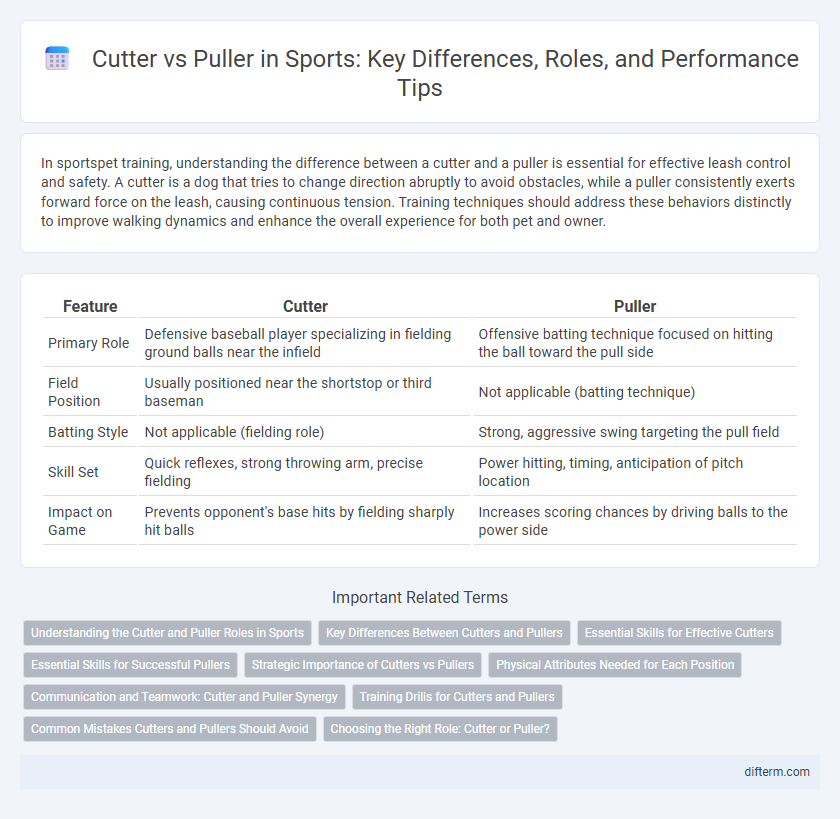In sportspet training, understanding the difference between a cutter and a puller is essential for effective leash control and safety. A cutter is a dog that tries to change direction abruptly to avoid obstacles, while a puller consistently exerts forward force on the leash, causing continuous tension. Training techniques should address these behaviors distinctly to improve walking dynamics and enhance the overall experience for both pet and owner.
Table of Comparison
| Feature | Cutter | Puller |
|---|---|---|
| Primary Role | Defensive baseball player specializing in fielding ground balls near the infield | Offensive batting technique focused on hitting the ball toward the pull side |
| Field Position | Usually positioned near the shortstop or third baseman | Not applicable (batting technique) |
| Batting Style | Not applicable (fielding role) | Strong, aggressive swing targeting the pull field |
| Skill Set | Quick reflexes, strong throwing arm, precise fielding | Power hitting, timing, anticipation of pitch location |
| Impact on Game | Prevents opponent's base hits by fielding sharply hit balls | Increases scoring chances by driving balls to the power side |
Understanding the Cutter and Puller Roles in Sports
The cutter in sports is a player who executes sharp, quick movements to evade defenders and create scoring opportunities, commonly seen in basketball and football. The puller serves as a strategic player who drags or pulls defenders out of position, creating space for teammates to exploit, crucial in sports like cricket and rugby. Understanding these roles enhances team dynamics by optimizing positioning and movement strategies for offensive success.
Key Differences Between Cutters and Pullers
Cutters are fast bowlers in cricket who use wrist and finger movement to impart lateral spin, causing the ball to deviate away from the batsman after pitching. Pullers, on the other hand, refer to a batting stroke where the batsman hits a short-pitched ball on the leg side, often targeting mid-wicket or square leg. The key difference lies in the bowling technique and ball trajectory for cutters, while pullers describe an aggressive batting shot played to counter short deliveries.
Essential Skills for Effective Cutters
Effective cutters in sports demonstrate precise timing and sharp agility to create separation from defenders, enabling successful reception and advancement of the ball. Mastery of spatial awareness and quick directional changes enhances their ability to exploit defensive gaps, increasing scoring opportunities. Consistent communication and synchronization with teammates ensure seamless execution of cutting routes and offensive strategies.
Essential Skills for Successful Pullers
Successful pullers in sports demonstrate exceptional hand-eye coordination and precise timing, enabling them to outmaneuver defenders and create scoring opportunities. Mastery of spatial awareness and fast footwork enhances their ability to exploit gaps and maintain balance during dynamic movements. Consistent practice of grip strength and wrist flexibility allows pullers to execute powerful, controlled strokes with accuracy and agility.
Strategic Importance of Cutters vs Pullers
Cutters and pullers serve distinct strategic roles in fast bowling, with cutters enhancing deception through subtle seam movement off the pitch, making it harder for batsmen to predict ball trajectory. Pullers, on the other hand, rely on aggressive, short-pitched deliveries aimed at unsettling batsmen and forcing mistakes under pressure. Mastery of both techniques allows bowlers to control game tempo and exploit batsmen's weaknesses effectively.
Physical Attributes Needed for Each Position
Cutters require explosive speed, agility, and quick reflexes to maneuver through tight defenses and create scoring opportunities. Pullers demand exceptional upper body strength, endurance, and precise hand-eye coordination for consistent throwing accuracy and maintaining defensive positions. Both positions benefit from superior spatial awareness and stamina to sustain high-intensity play throughout the game.
Communication and Teamwork: Cutter and Puller Synergy
Cutter and Puller roles in sports require seamless communication and teamwork to execute plays effectively. The cutter relies on precise signals from the puller to time cuts and create scoring opportunities, while the puller depends on the cutter's movements to adjust throws and maintain offensive flow. This synergy enhances overall team coordination and maximizes scoring potential.
Training Drills for Cutters and Pullers
Training drills for cutters emphasize agility and sharp angular movements, including cone drills and quick change-of-direction exercises to enhance cutting speed and precision. Puller drills focus on explosive power and hand-eye coordination, utilizing resistance bands and reaction ball drills to improve ball control and pulling accuracy. Both training regimens incorporate plyometric exercises to boost overall athletic performance and injury prevention.
Common Mistakes Cutters and Pullers Should Avoid
Cutters often mistake excessive wrist movement for power, resulting in loss of control and inconsistent line, while pullers frequently overcommit their body, causing imbalance and errant shots. Both should avoid improper foot positioning, which undermines stability and shot accuracy. Developing a smooth, controlled swing with proper weight transfer is essential to maximize effectiveness and reduce the risk of common technical errors.
Choosing the Right Role: Cutter or Puller?
Selecting between a cutter and a puller hinges on a player's batting style and field conditions. Cutters excel with sharp, horizontal bat movements to redirect fast balls, ideal for square-leg gaps, while pullers dominate short, powerful swings targeting mid-wicket areas against short-pitched deliveries. Analyzing pitch behavior and bowling speed aids in optimizing the choice, enhancing scoring opportunities and strategic play.
Cutter vs Puller Infographic

 difterm.com
difterm.com